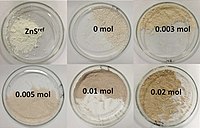
Photo from wikipedia
Abstract In this study, copper-doped zinc sulfide nanoballs were successfully synthesized in DI water and ethanol solvent by a sonochemical approach using surfactants in aqueous medium, such as citric acid… Click to show full abstract
Abstract In this study, copper-doped zinc sulfide nanoballs were successfully synthesized in DI water and ethanol solvent by a sonochemical approach using surfactants in aqueous medium, such as citric acid (CIT), sodium dodecyl sulfate (SDS), cetyltrimethylammonium bromide (CTAB), cetylpyridinium bromide (CPBr), polyethylene glycol (PEG), polyvinyl pyrrolidone (PVP), and polyvinyl butyral (PVB). Since surfactants are usually organic compounds that are amphiphilic molecules and surface-active agents with unique properties stemming from their exclusive structure with a hydrophobic tail and hydrophilic head, they can self-organize to form colloidal aggregates of different morphologies. TEM images show that copper doped ZnS crystallites without surfactant have a hollow-sphere-like self-assembled nanostructure. When 2.0Cu/ZnS was prepared with CTAB surfactant, it had a flower-like microspheres. The other surfactants would make copper-doped zinc sulfide exhibit the nanospheric structure. The surfactant plays an important role on the transfer of photogenerated electrons and holes and prevents non-radiative recombination of electrons and holes at surface sites. Therefore, surfactants could significantly improve the photocatalytic activity. Hydrogen evolution from an aqueous solution containing 0.1 M Na2S at pH 3 and 0.15 g L−1 of 2.0Cu/ZnS photocatalyst with PVB surfactant had the maximum of 1137.5 μmol h−1 g−1.
Journal Title: International Journal of Hydrogen Energy
Year Published: 2019
Link to full text (if available)
Share on Social Media: Sign Up to like & get
recommendations!